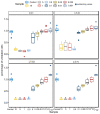Effect of New Surfactants on Biological Properties of Liquid Soaps
- PMID: 36080193
- PMCID: PMC9458098
- DOI: 10.3390/molecules27175425
Effect of New Surfactants on Biological Properties of Liquid Soaps
Abstract
Liquid soaps are the basic cosmetics used to clean the skin of the hands. Frequent hand washing prevents viral contamination but may damage the skin's hydro-lipid layer, leading to various types of irritation. Therefore, four liquid soap formulas were developed with three amphoteric surfactants: Cocamidopropyl Betaine (LS II), CocamidopropylHydroxysultaine (LS III), and newly synthesized Evening PrimroseaamidopropylSulfobetaine (LS IV). We evaluated the skin irritating potential (zein number, bovine albumin test) and cytotoxicity (AlamarBlue™, Cell viability, and Cell cycle assays) on HaCaT cell line. We observed lower values of the zein number and bovine albumin tests after adding soaps with surfactants (the highest differences in LS IV) compared to the base soap (LS I). However, LS I and LS II did not differ in cytotoxic assays. Therefore, adding LS III and LS IV seems potentially more dangerous to the cells. However, it should be noted that cells were continuously exposed to liquid soaps for more than 24 h, so its cytotoxic effects after dermal use in humans may be unnoticeable. Concluding, results suggest that the newly synthesized LS IV should improve the safety of liquid hand washing soaps.
Keywords: amphoteric surfactant; cytotoxicity; irritating effect; keratinocytes; liquid soaps; zein number.
Conflict of interest statement
The authors declare no conflict of interest.
Figures





References
-
- Yao R.T., Langer E.R., Leckie A., Tremblay L.A. Household Preferences When Purchasing Handwashing Liquid Soap: A Choice Experiment Application. J. Clean. Prod. 2019;235:1515–1524. doi: 10.1016/j.jclepro.2019.07.002. - DOI
MeSH terms
Substances
Grants and funding
LinkOut - more resources
Full Text Sources

